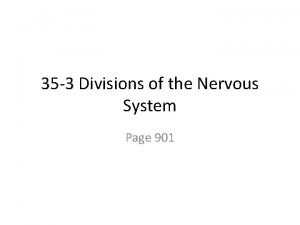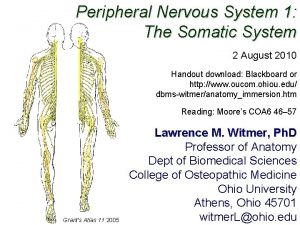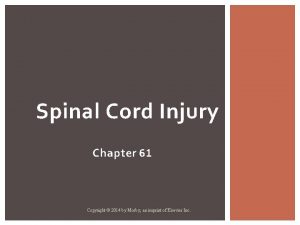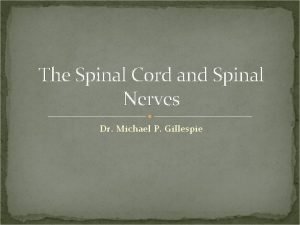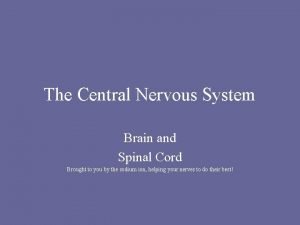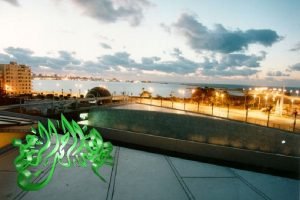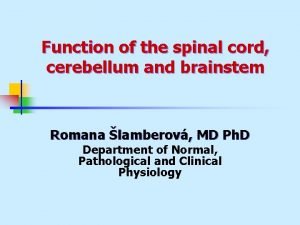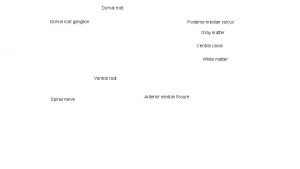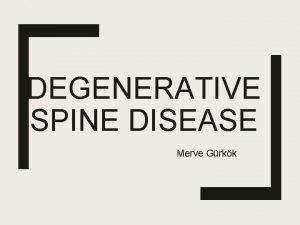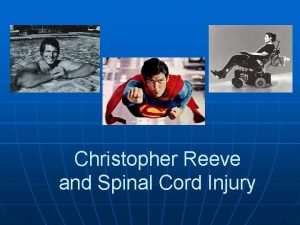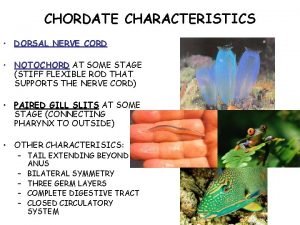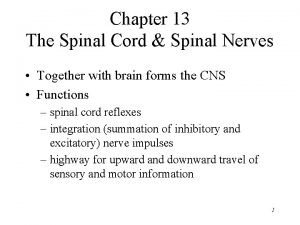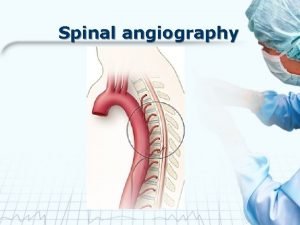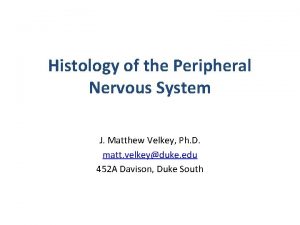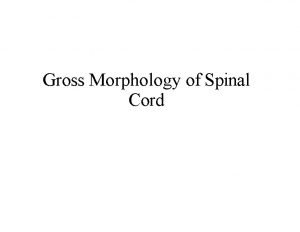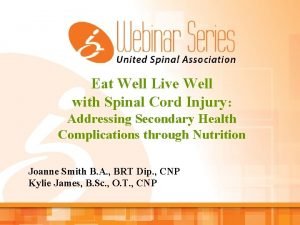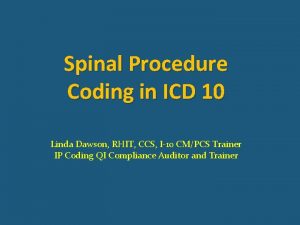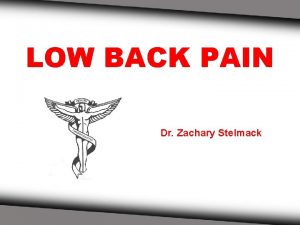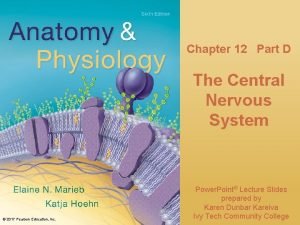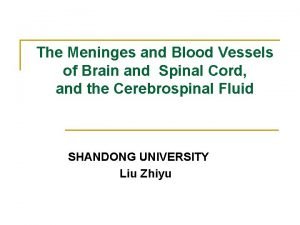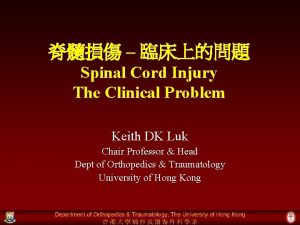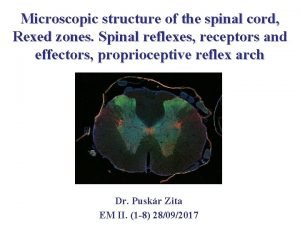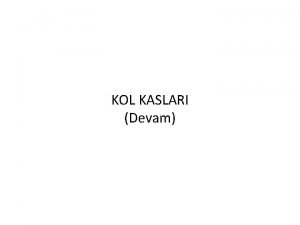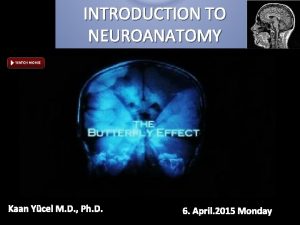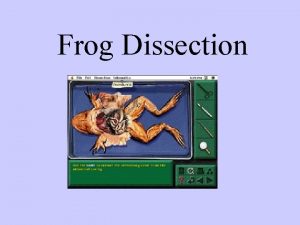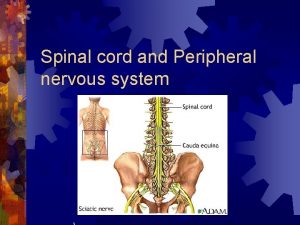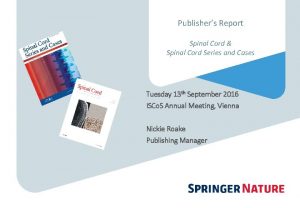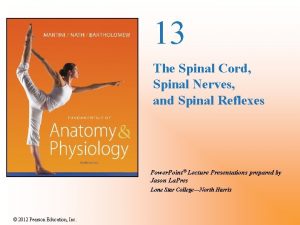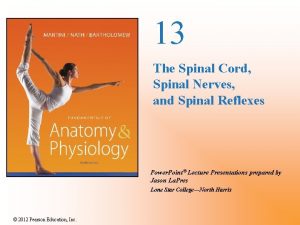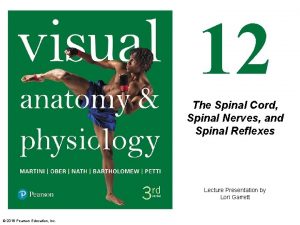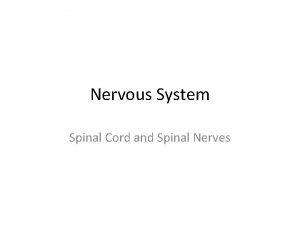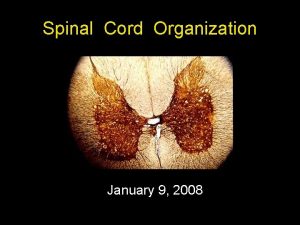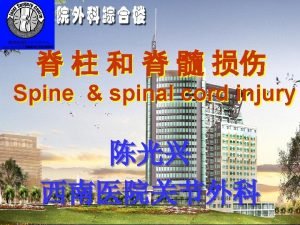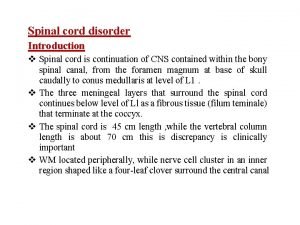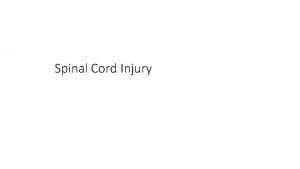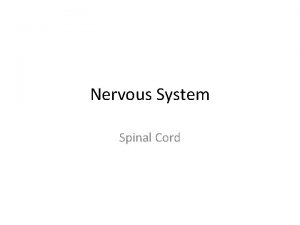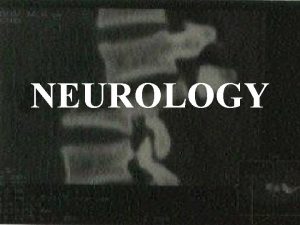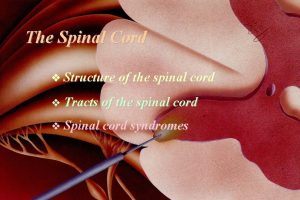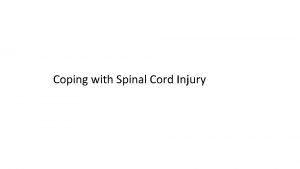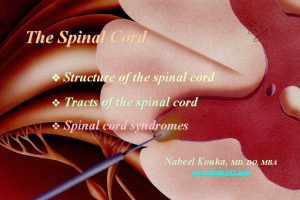Compressive and non compressive spinal cord syndrome Dr










































- Slides: 42

Compressive and non compressive spinal cord syndrome Dr. H. N. Sarker MBBS, FCPS (Medicine), MACP(USA), MRCP(UK), MRCPS(GLASGO), FRCP(Edin) Associate Professor Medicine SBMC, Barisal 25. 05. 2009 Dr. H. N. Sarker

INTRODUCTION Spinal cord is a long , thin tubular structure of central nervous system which extends from foramen magnum to lower border of first lumbar vertebra. It is covered by three meninges – Dura, arachnoid, and pia matters. 25. 05. 2009 Dr. H. N. Sarker

25. 05. 2009 Dr. H. N. Sarker

INTRODUCTION…. Spinal cord consists of 31 spinal segments from which corresponding pair of spinal nerve arise. Since the spinal cord is shorter than vertebral canal , spinal segment does not correspond with vertebra. 25. 05. 2009 Dr. H. N. Sarker

INTRODUCTION There are two enlargements in spinal cord – v cervical (C 4 -T 1) from which nerves supplying the upper limbs arise v lumbar (L 1 -S 3) from which nerves supplying lower limbs arise. 25. 05. 2009 Dr. H. N. Sarker

Blood Supply Spinal cord is supplied by n a single anterior spinal artery – which supplies anterior two thirds of spinal cord n Two posterior spinal arteries- which, supplemented by segmental arteries supply posterior one third of the cord. 25. 05. 2009 Dr. H. N. Sarker

25. 05. 2009 Dr. H. N. Sarker

Neuroanatomy n Any lesion of the spinal cord produces effects involving the spinal segment(s) and long tract(s) of the spinal cord. So, to understand the effect of any lesion you should clearly understand anatomical arrangement of the spinal segment and long tracts. 25. 05. 2009 Dr. H. N. Sarker

Neuroanatomy Each segment consists of central gray matter n peripheral white matter n 25. 05. 2009 Dr. H. N. Sarker

25. 05. 2009 Dr. H. N. Sarker

Neuroanatomy Central gray matter: Composed of nerve cells which are arranged as n anterior horn cell- lower motor neuron n Posterior horn cellØ Sensory neuron Ø Second order neuron Ø Fibre from this neurons crosses within the segment to the opposite side to form lateral spinothalamic tract. First order neuron lies in dorsal root ganglion of spinal cord. 25. 05. 2009 Dr. H. N. Sarker

Neuroanatomy Peripheral white matter: n It contains bundles of fibres that are called tracts. 25. 05. 2009 Dr. H. N. Sarker

Neuroanatomy Long tracts: n There at least 10 tracts in spinal cord; But we are interested in only three long tracts- corticospinal tract, spinothalamic tract and dorsal column which subserves most of the functions. 25. 05. 2009 Dr. H. N. Sarker

Neuroanatomy Corticospinal tract: n It produces ipsilateral upper motor neuron lesion as the fibres of the tract crosses at medullae oblongata. 25. 05. 2009 Dr. H. N. Sarker

25. 05. 2009 Dr. H. N. Sarker

Neuroanatomy Spinothalamic tract: n It contains fibers for pain, crude touch and temperature. Since fibers of 2 nd order neuron crosses within the segment to opposite side , any lesion of the tract leads to loss of pain and temperature sensation of opposite of the body below the lesion. 25. 05. 2009 Dr. H. N. Sarker

25. 05. 2009 Dr. H. N. Sarker

Neuroanatomy Dorsal column: n It carries sense of position and vibration and fine touch. As the fibres croses midline at medullae oblongata, so lesion in the tract produce ipsilateral loss of sense of position and vibration and fine touch. 25. 05. 2009 Dr. H. N. Sarker

Compressive Spinal cord lesion: Common causes Site Frequency Causes Vertebral 80% Trauma (extradural) Intervertebral disc prolapse Metastatic carcinoma (e. g. breast, prostate, bronchus) Myeloma Tuberculosis Meninges (intradural extramedullary 15% Tumours (e. g. meningioma, neurofibroma, ependymoma, metastasis, lymphoma, leukaemia) Spinal cord (intradural intramedullary 5% Epidural abscess Tumours (e. g. glioma, ependymoma, metastasis 25. 05. 2009 Dr. H. N. Sarker

Compressive Spinal cord lesion Clinical features: n Onset is usually slow (over weeks) but can be acute as a result of trauma or metastases. 25. 05. 2009 Dr. H. N. Sarker

25. 05. 2009 Dr. H. N. Sarker

SYMPTOMS OF SPINAL CORD COMPRESSION n Pain: v Localised over the spine or in a root distribution, which may be aggravated by coughing, sneezing or straining n Sensory: v Paraesthesia, numbness or cold sensations, especially in the lower limbs, which spread proximally, often to a level on the trunk 25. 05. 2009 Dr. H. N. Sarker

SYMPTOMS OF SPINAL CORD COMPRESSION n Motor : v Weakness, heaviness or stiffness of the limbs, most commonly the legs n Sphincters: v Urgency or hesitancy of micturition, leading eventually to retention. 25. 05. 2009 Dr. H. N. Sarker

SIGNS OF SPINAL CORD COMPRESSION n Signs depends on site of lesion and completeness of involvement. 25. 05. 2009 Dr. H. N. Sarker

SIGNS OF SPINAL CORD COMPRESSION Cervical, above C 5: Ø Upper motor neuron signs and sensory loss in all four limbs Diaphragm weakness (phrenic nerve) n Cervical, C 5 to T 1: Ø Lower motor neuron signs and segmental sensory loss in the arms; upper motor neuron signs in the legs Respiratory (intercostal) muscle weakness Ø Ø Ø 25. 05. 2009 Dr. H. N. Sarker

SIGNS OF SPINAL CORD COMPRESSION n Thoracic cord : Ø Spastic paraplegia with a sensory level on the trunk n Conus medullaris: Ø Lesions at the end of the spinal cord cause sacral loss of sensation and extensor plantar responses 25. 05. 2009 Dr. H. N. Sarker

SIGNS OF SPINAL CORD COMPRESSION n Cauda equina : Ø Spinal cord ends at approximately the T 12/L 1 spinal level and spinal lesions below this level can only cause lower motor neuron signs by affecting the cauda equine. 25. 05. 2009 Dr. H. N. Sarker

Signs of partial transection of spinal cord (Brown- Sequard syndrome) Site of Lesion Ipsilateral At the level Hyperaesthesia Below the level UMN lesion Loss of Propioception and vibration. 25. 05. 2009 Dr. H. N. Sarker Contralateral Loss of pain and thermal sensation.

25. 05. 2009 Dr. H. N. Sarker

Investigation Plain X-rays of spine n MRI of spine or myelography n Chest X-rays n CSF n Serum B 12 n 25. 05. 2009 Dr. H. N. Sarker

Management General measures q Care of skin: v Meticulous attention must be paid to cleanliness and to turning pt two hrly v Inspect pressure areas regularly v Use pressure mattress v Treat any pressure sore n 25. 05. 2009 Dr. H. N. Sarker

Management n v General measures……. Care of Bladder: n Self v catheterization or reflex bladder emptying Care of Bowel: n Constipation and fecal impacation must be avoided. 25. 05. 2009 Dr. H. N. Sarker

Management q v General measures…… Care of paralysed limbs: Ø Passive physiotherapy to prevent contracture. Ø Severe spasticity may be helped by beclofen or diazepam. 25. 05. 2009 Dr. H. N. Sarker

Management q Specific measure: Ø Treatment of the underlying cause e. g. anti TB in pott’s disease. q Rehabilitation 25. 05. 2009 Dr. H. N. Sarker

Non compressive spinal cord syndrome cause conditions Hereditary spastic paraplegia, Friedreich’s ataxia Infective/inflammatory Transverse myelitis, MS, Syphilis Vascular Anterior spinal artery infarct Spinal AVM Metabolic Vitamin B 12 deficiency (subacute combined degeneration Degenerative Motor neuron disease, Syringomyelia 25. 05. 2009 Dr. H. N. Sarker

Acute Transverse Myelitis is an acute, often monophasic inflammatory demyelinating disease affecting the spinal cord over a variable number of segments. 25. 05. 2009 Dr. H. N. Sarker

Aetiology Multiple Sclerosis n Post infectious e. g. CMV n Post vaccination n Trauma n Surgery n 25. 05. 2009 Dr. H. N. Sarker

Clinical Feature Any age n Subacute onset n May be severe neck or back pain n Spastic paraparesis n Definite sensory level n Sphincter involvement- Initially urinary retention later on incontinence n 25. 05. 2009 Dr. H. N. Sarker

Investigation MRI n CSF study n 25. 05. 2009 Dr. H. N. Sarker

Management n General measures Ø As n for a paralysed patient Specific measure: Ø High dose intravenous methyl prednisolone. 25. 05. 2009 Dr. H. N. Sarker

Prognosis Variable n One third recovered completely n One third remains with residual disability n One third bed ridden. n 25. 05. 2009 Dr. H. N. Sarker

25. 05. 2009 Dr. H. N. Sarker
 Spinal cord
Spinal cord Spine meninges
Spine meninges Median nerve innervates
Median nerve innervates Cervical and brachial plexus
Cervical and brachial plexus Trachea and spinal cord
Trachea and spinal cord Spinal cord and brain
Spinal cord and brain Dermatome map
Dermatome map Somi brace
Somi brace Ganglion on spine
Ganglion on spine Spinal cord denticulate ligament
Spinal cord denticulate ligament Spinal cord structures
Spinal cord structures Hyporeflexia and hyperreflexia
Hyporeflexia and hyperreflexia Spinal cord tumors
Spinal cord tumors Pons function
Pons function Ventral median fissure
Ventral median fissure Scottie dog lumbar spine
Scottie dog lumbar spine Christopher reeve spinal cord injury level
Christopher reeve spinal cord injury level Bird air sac
Bird air sac Spinal cover
Spinal cover Components of reflex arc
Components of reflex arc Spinal cord organization
Spinal cord organization Cervical and brachial plexus
Cervical and brachial plexus Osd sindrom
Osd sindrom Somatic nervous system
Somatic nervous system Spinal angiogram
Spinal angiogram Mezgovnice
Mezgovnice Spinal cord
Spinal cord Tissue
Tissue Lumbar puncture introduction
Lumbar puncture introduction Eat well live well with spinal cord injury
Eat well live well with spinal cord injury Neural foraminal stenosis icd 10
Neural foraminal stenosis icd 10 Pain pathway spinal cord
Pain pathway spinal cord The spinal cord anatomy
The spinal cord anatomy Spinal cord cross section
Spinal cord cross section Formation of csf
Formation of csf Christopher reeve ventilator
Christopher reeve ventilator Spinal cord
Spinal cord Spinal cord injury shoulder exercises
Spinal cord injury shoulder exercises Mechanoreceptor
Mechanoreceptor M. anconeus
M. anconeus Subthalamus
Subthalamus Frog
Frog Pyramidal system
Pyramidal system





